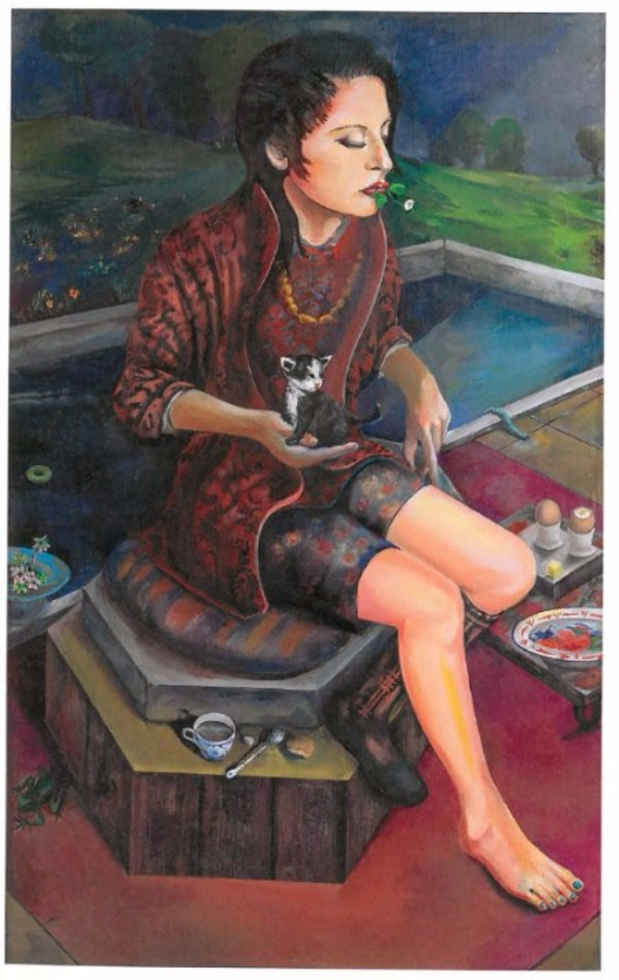Martial Raysse “VISAGES”
Lévy Gorvy

[Image: Martial Raysse "Le Jour où Gilbert s'est noyé" (2012) Acrylic paint and oil on wood, 56 5⁄16 × 35 7⁄16 in. Collection Martial Raysse]
This event has ended.
Raysse began making portraits in 1961. Composed in a bold, exuberant palette that he termed “Martialcolor,” these early paintings were based on stereotypical images of the female face gathered from classical paintings and popular media, such as advertisements, fashion catalogs, and publicity stills. Defined by vibrant hues and sharp contrasts, they dispensed with naturalism in deliberate pursuit of what the artist praised as “false relationships” and “bad taste.” Raysse’s most recent portraits, while still executed in an intensive color palette, seek to convey the essential nature of their sitters. His subjects gaze out from the canvas but seem to simultaneously look inward, as if lost in thought, exuding a sense of pathos and enigma that leaves the viewer intrigued and unsettled.
Martial Raysse: Visages presents Portrait de Gabriella la jolie vènetienne (1963) alongside works that date from 2008 to the present. Combining canvases with store-bought trinkets, including a fake rose, a plastic earring, and a miniature gondola, this mixed-media work uses the female face to explore the entwinement of beauty and artifice. Its subjects— two anonymous women whose mouths are frozen in forced smiles—are made nearly unidentifiable through Raysse’s distortion of their images. The kitschy objects that adorn this construction further obscure the faces, and the canvases are joined in an uneven, almost slapdash, manner.
Over twenty recent works on view build upon the themes of this early important example. Shown at Lévy Gorvy for the first time, NOW and QUE VEUX TU DIRE MON BEL AMI (both 2017) are marked by ambiguity and disjuncture. In the first, four men, each resembling a stock character from painting or literature, stand behind a seductive woman whose legs are alluringly crossed atop a patterned chair. The relationships between these figures is undefined, and each appears detached from the others. Posed before a violent tableaux (a picture within the picture that pays homage to the sweeping compositions of classical history painting), the scene appears as a suspended moment in a mysterious narrative. QUE VEUX TU DIRE MON BEL AMI is characterized by a similar sense of incongruity. Its subject, an androgynous figure dressed in a coat and blazer, balances a blank notebook in one hand and a worm-ridden apple atop the other. Though symbolically suggestive, these objects remain ambiguous, leaving the viewer to wonder at the artist’s intention.
Un beau merle (2008), Ces deux gars-là (2008), and Songeuse Roxane (2013) further demonstrate Raysse’s talent for cultivating mystery in portraiture. The first features a man, his skin colored green, staring quizzically out at the viewer. The second pairs two figures. One is clad in a soiled gardener’s hat, while the other sports a laurel wreath topped, inexplicably, with an open can. The third depicts a young woman against an acid red-and-orange ground. Her expression is haunting and her lips are parted, as if on the verge of speech. Each of these paintings moves between surface appearance and psychic depth, conveying a nuanced range of emotions that are left to viewers’ interpretations. Together, they express the eccentric wonder of Raysse’s artistic vision, and his desire to strike what he has described as an “equilibrium between the classical and the modern, between that which remains exemplary and that which suits the present.”
Martial Raysse: Visages will be complemented by a publication featuring essays by curator and art historian Jane Livingston and sociologist Dr. Eduardo de la Fuente, as well as a specially commissioned poem by Leopoldine Core.
Media
Schedule
from February 28, 2018 to April 14, 2018
Opening Reception on 2018-02-28 from 18:00 to 20:00